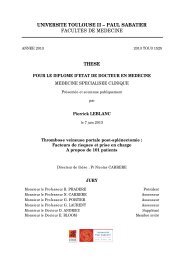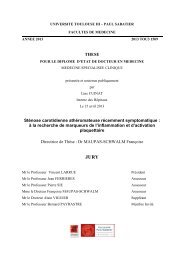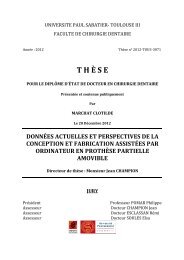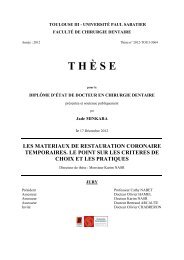Télécharger (1293Kb) - Thèses d'exercice de Santé - Université ...
Télécharger (1293Kb) - Thèses d'exercice de Santé - Université ...
Télécharger (1293Kb) - Thèses d'exercice de Santé - Université ...
You also want an ePaper? Increase the reach of your titles
YUMPU automatically turns print PDFs into web optimized ePapers that Google loves.
11<br />
a. L’accueil du patient ------------------------------------------------------- 37<br />
b. Le dialogue préalable à l’examen clinique ---------------------------- 38<br />
c. La synthèse et la discussion après examen clinique ----------------- 39<br />
2. Les points à éviter ------------------------------------------------------------- 40<br />
Partie 2 : La gestion <strong>de</strong> la relation <strong>de</strong> soin en situations spécifiques ------------------------- 43<br />
I. La relation <strong>de</strong> soin avec le jeune patient ------------------------------------ 44<br />
1. Le triangle relationnel parents-enfant-praticien --------------------------- 44<br />
2. La relation <strong>de</strong> soin en fonction <strong>de</strong> l’âge du patient ----------------------- 45<br />
a. La petite enfance : <strong>de</strong> un à cinq ans ------------------------------------ 45<br />
b. L’enfance : <strong>de</strong> six à neuf ans -------------------------------------------- 46<br />
c. La préadolescence et l’adolescence ------------------------------------ 46<br />
3. Les techniques <strong>de</strong> communication et d’influence du comportement -- 47<br />
a. Le langage imaginaire --------------------------------------------------- 47<br />
b. La préexposition ---------------------------------------------------------- 47<br />
c. La métho<strong>de</strong> du « Tell, Show, Do » ------------------------------------- 48<br />
d. Le renforcement positif -------------------------------------------------- 48<br />
e. Les techniques <strong>de</strong> distraction ------------------------------------------- 48<br />
II. La relation <strong>de</strong> soin avec le patient âgé --------------------------------------- 49<br />
1. Difficultés <strong>de</strong> communication liées à l’âge -------------------------------- 50<br />
2. Une communication adaptée ------------------------------------------------ 52<br />
III. La relation <strong>de</strong> soin avec le patient en situation <strong>de</strong> handicap ------------ 54<br />
1. Le cas du handicap mental --------------------------------------------------- 55<br />
a. Une population aux besoins spécifiques ------------------------------- 55<br />
b. Prise en charge <strong>de</strong>s patients atteints <strong>de</strong> déficience intellectuelle --- 56<br />
b1. Le patient présentant <strong>de</strong>s capacités intellectuelles limitées ---- 56<br />
b2. Le patient présentant une déficience intellectuelle légère ou<br />
modérée -------------------------------------------------------------------- 57<br />
b3. Le patient présentant une déficience intellectuelle sévère ou<br />
profon<strong>de</strong> ------------------------------------------------------------------- 59<br />
2. Le cas du handicap physique ------------------------------------------------ 60<br />
a. Le patient atteint <strong>de</strong> surdité --------------------------------------------- 60







